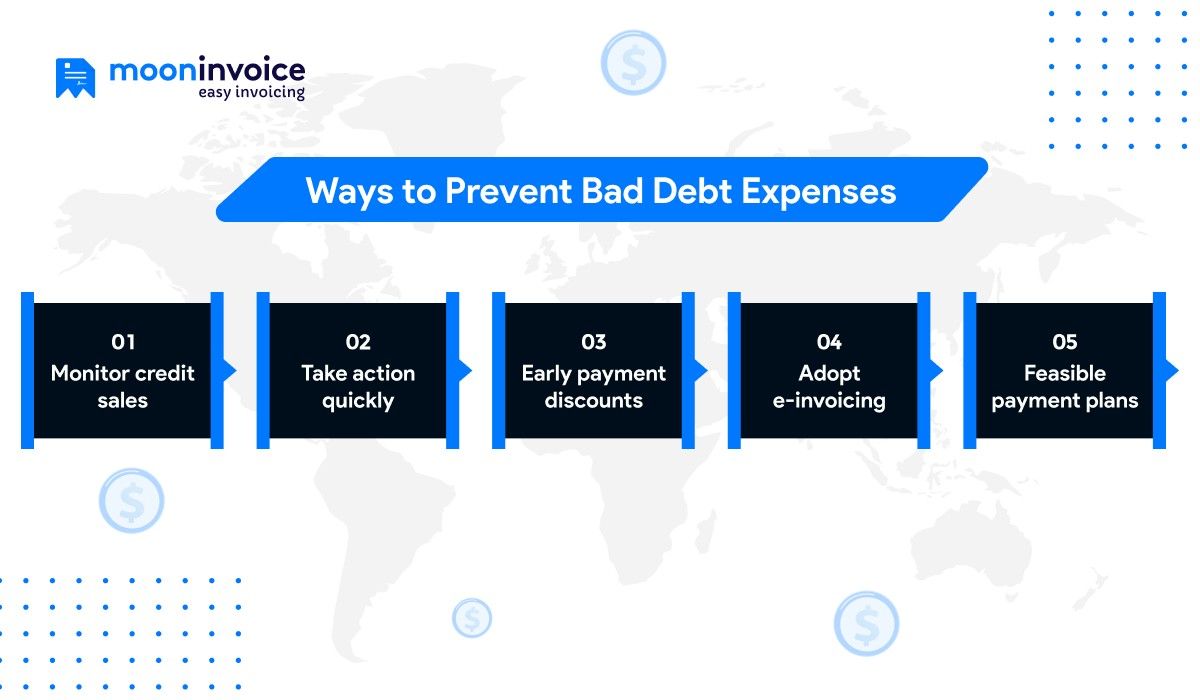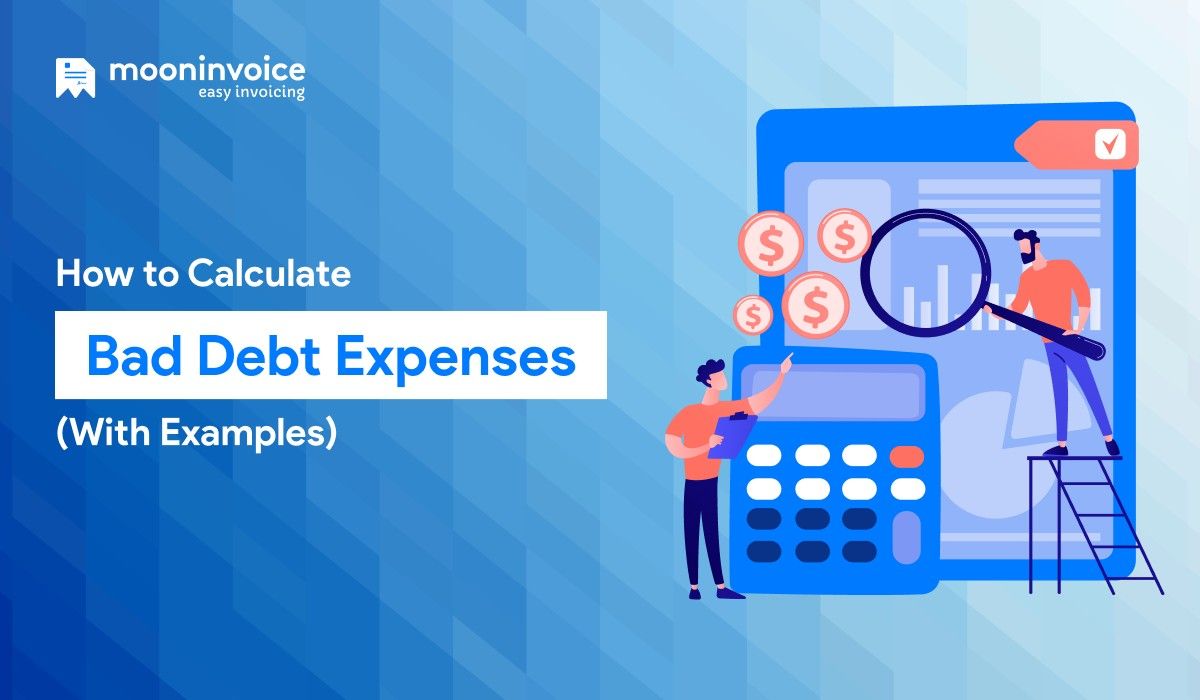If you see unpaid invoices quietly piling up on your desk or messaging inbox, then it’s an early warning sign that bad debt could be on the way. Calculating bad debt expenses in the right way can help you get ready for your next move.
Here, we will walk you through what bad debt expenses are and how to find bad debt expenses, along with the bad debt expense formula.
What is a Bad Debt Expense?
Bad debt expense is the cost incurred by a business when it gives up collecting from a delinquent customer.
If you sell an item on credit, the due amount is recorded in accounts receivable. Then, it’s the customer who is responsible for paying their dues, but somehow they keep delaying the payment and eventually fail to pay the money.
When you realize the money is no longer receivable, even after sending multiple payment reminders, it becomes a doubtful debt, which is what you call bad debt expense.
How to Calculate Bad Debt Expense?
Businesses can determine their bad debt in several ways, including the direct write-off method or allowance method. Let us explain to you in detail.
How to calculate bad debts expense using write-off method
This is the easiest way to figure out your bad debts, but one needs to remember that it can’t be so accurate. You can opt for this method only when you get the confirmation that the invoice recipient won’t pay the money, no matter what.
Assuming you are aware that a buyer isn’t going to pay the money, simply include a bad debt expense journal entry in your accounting books. Plus, make sure the amount you are writing off equates the accounts receivable value, i.e., what the customer truly owes.
For example, say you own a small furniture shop and recently sold a table set worth $5500 on credit. This $5500 goes straight into your accounts receivable because this is something you are expecting to receive later.
After a few months, you realize the customer has no intention to pay the money, so what you do is write-off the amount from accounts receivable and label it as bad debt expense.
This way, you can use the direct write-offs method for small amounts that you are never going to receive. For such cases, when you enter the tax season, the IRS will also allow you to deduct these bad debts if and only if you make it clear that the customer won’t pay.
Let Us Be That Bad Guy
We don’t mind playing the villain to collect your money while you stay the hero, doing everything to make the debt disappear.
How to find bad debt expense using allowance method
Another way is to calculate bad debt using the allowance method. An accounting method that is used when you have done too much business on credit, and not just small transactions. So, if you rely heavily on credit sales, then you should go by this method without a second thought.
Choosing this bad debt allowance method, all you need to do is guesstimate how many customers are likely to avoid payment. Once you get an idea of the amount in uncollectible accounts in the future, keep reserve funds in a separate account – allowance for doubtful accounts. Whatever you keep as a bad debt reserve is based on the client’s payment records and a few circumstances.
Nowadays, many businesses consider using a percentage formula for bad debt expense when it comes to maintaining an allowance account for doubtful accounts. Wondering what exactly it is? Let’s find out.
Bad debt percentage method
It is a simple method to forecast how much money you are likely to lose from those who usually don’t clear their dues. Looking at the credit sales and past bad debt records, you need to calculate the final percentage of bad debts.
For example, you mostly do business on credit. This year, you made a total credit sales of $440,900, from which $18,300 remained unpaid, regardless of what could be the reason behind this.
So, next you do is use the below formula and populate the details in order to know the bad debt percentage.
Bad Debt Percentage Formula
Percentage of bad debt = Total bad debts / Total credit sales
Using the formula, what you estimate is:
18,300 / 440,900 = 4.15% (Percentage of bad debt)
Now, this is an estimate of the amount that you might fail to collect in the future, meaning you need to create an allowance for such doubtful debts equal to 4.15%.
Suppose you have $32,000 credit sales alone in October month, then you need to keep aside $1,328 in your allowance for doubtful accounts.
How to calculate bad debt expense using aging method
The aging method is another way to figure out how much bad debt you might have to deal with. Unlike the allowance method, the aging method digs deeper by looking at your total sales and each unpaid invoice. Basically, it relies on the age of your outstanding invoices, like how long it has been overdue (like 0 to 30 days, more)
The accounts receivable aging method is based on a simple rule – the older the invoice, the harder it is to collect the payment. If you opt for this method, then make sure you allocate a bad debt percentage to each aging category.
For example, recently issued bills that are just a few weeks late (0–30 days) might have a 1% chance of not being paid. But those bills sit unpaid for over 90 days, then there’s a 50% chance you will fail to receive that money.
As a result, you can send polite reminders to earlier age categories and simultaneously, take strict actions for older age categories.
How to Record Bad Debt Expenses?
So far, you understand how is bad debt expense calculated. Therefore, assuming you are done estimating bad debt, now you can use the aging method or allowance method. Let’s move straightaway to the crucial step, i.e., to register the journal entry.
1. Journal entry
Once you know what could be your bad debt, make a new entry under the bad debt expense account section in your journal. If needed, you can also create a separate category for bad debt where you record the amount that seems to be uncollectible. This way, you can spot repetitive issues by checking the journal entry frequently.
However, if you are relying on the allowance method, you need to make a debit entry from the expenses account and a credit entry in allowance for doubtful accounts.
2. Update accounts receivable
Simultaneously, you also need to adjust your accounts receivable. So, find the customer who hasn’t paid the money and write off the amount in your accounts receivable spreadsheet (or reduce the contra asset account). Now, this means you are no longer expecting the payment from them.
Upon reducing the accounts receivable balance, make sure the remaining outstanding accounts receivable are still collectible from customers.
5 Ways to Prevent Bad Debt Expenses

If you are wondering how to get rid of bad debts, then below are some practical ways to follow.
1. Monitor credit sales
Keep a tab on tracking credit sales regularly to learn about potential risks early and take precautionary measures. Also, you can identify late payers and ask them to pay upfront from next time.
2. Take action quickly
Harness the proactive collections approach and initiate the necessary actions as quickly as possible. Otherwise, things may spiral out of your hands and lead to delayed payments or uncollectible debts.
3. Early payment discounts
Introduce early discounts for quick payers to mitigate the risk of bad debt. Sometimes, offering a small discount on the total invoice amount can inspire customers to clear their dues in a timely manner.
4. Adopt e-invoicing
Migrating to the e-invoicing process can also help you overcome bad debt challenges as it takes less time to process clearer invoices, which facilitates faster payments from your customers.
5. Feasible payment plans
You can resort to negotiating payment plans if nothing works in your favor. Get in touch with your customers and provide feasible plans that will aid them in settling their outstanding amount.
Automate Your Bookkeeping With Moon Invoice
If manual bookkeeping steals your time and effort, then you badly need an accounting or invoicing software that tackles the costly errors and keeps bad debts at bay.
An advanced invoicing software, Moon Invoice, can help you automate your bookkeeping in such a way that you stay ahead of errors and delayed payments.
You can create professional and nice-looking invoices that quickly get paid. Following that, it updates accounting records and financial statements in real-time so that you can check invoice and payment status on the go.
This means you don’t have to perform manual entries or check who hasn’t paid money one by one in the balance sheet. If required, you can simply turn on the automated reminders instead of nudging customers to clear the dues on the phone calls.
Is Manual Bookkeeping Slowing Your Business Down?
Let Moon Invoice’s AI-driven automation take over your traditional bookkeeping and pave the way for steady business growth.
Wrapping Up
Keeping track of bad debt accounts definitely helps you in avoiding unwanted surprises. You can nab at-risk customers early and, accordingly, make payment arrangements to combat cash flow problems. In such cases, having accounting or expense tracking software can really make a difference.
It not only simplifies your bookkeeping process but also significantly lessens the chances of bad debts. Even better, it frees you up from manual editing and helps you concentrate on what’s important for your business. Don’t believe us? Claim a free trial and explore by yourself.



















